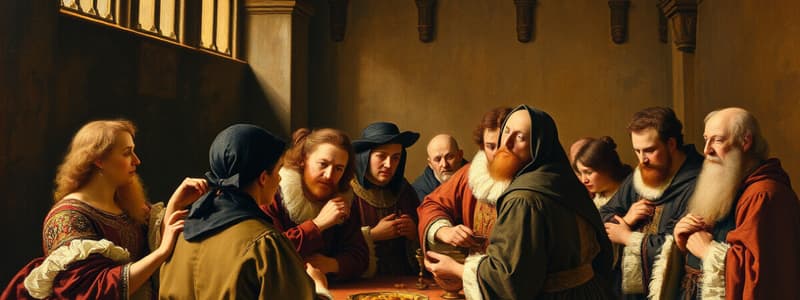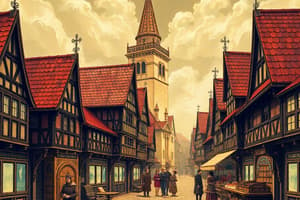Podcast
Questions and Answers
What were guilds?
What were guilds?
Guilds were an organization of people in the same craft or trade.
Why were guilds established?
Why were guilds established?
They helped and protected people doing a certain kind of work and maintained high standards.
How did a person become a member of a guild?
How did a person become a member of a guild?
First, one must become an apprentice, then after 7 years, the apprentice will create a masterpiece for the guild to approve, and then they can open their own business.
What are some examples of craft guilds in medieval Europe?
What are some examples of craft guilds in medieval Europe?
How did guilds help members and families of members?
How did guilds help members and families of members?
What role did merchants play in the growth of medieval European towns?
What role did merchants play in the growth of medieval European towns?
What were merchant fairs like?
What were merchant fairs like?
How did merchants become the most wealthy and powerful members of towns?
How did merchants become the most wealthy and powerful members of towns?
How were Jews often mistreated in medieval Europe?
How were Jews often mistreated in medieval Europe?
What did homes in medieval European towns look like?
What did homes in medieval European towns look like?
Why were the homes of most town dwellers uncomfortable?
Why were the homes of most town dwellers uncomfortable?
Why was growing up in medieval towns difficult?
Why was growing up in medieval towns difficult?
How were the lives of medieval girls different from those of modern girls?
How were the lives of medieval girls different from those of modern girls?
How did unhealthy living conditions and limited medical knowledge affect life in medieval European towns?
How did unhealthy living conditions and limited medical knowledge affect life in medieval European towns?
What were some common diseases in medieval Europe?
What were some common diseases in medieval Europe?
What were some common practices used by medieval doctors?
What were some common practices used by medieval doctors?
What group was sometimes blamed when an outbreak of disease occurred?
What group was sometimes blamed when an outbreak of disease occurred?
Why were towns in medieval Europe dangerous places?
Why were towns in medieval Europe dangerous places?
What were two methods for deciding the guilt or innocence of accused criminals in the early Middle Ages?
What were two methods for deciding the guilt or innocence of accused criminals in the early Middle Ages?
What were some ways criminals were punished in medieval Europe?
What were some ways criminals were punished in medieval Europe?
How did the treatment of those accused of crimes begin to improve in the 12th century?
How did the treatment of those accused of crimes begin to improve in the 12th century?
What were some games that were popular with children in medieval Europe?
What were some games that were popular with children in medieval Europe?
Flashcards are hidden until you start studying
Study Notes
Guilds and Their Role
- Guilds were organizations of artisans and merchants in the same craft or trade.
- Established to protect members, maintain quality standards, and provide support.
- Candidates became apprentices, worked for seven years, then presented a masterpiece for guild approval to become a full member.
- Examples of craft guilds include cloth makers, cobblers, and stonemasons.
Impact of Guilds on Society
- Guilds controlled working hours and set prices, aiding their members and families.
- Addressed complaints and provided a sense of community among crafters.
- Merchant's guilds dominated business life, running sizable businesses and participating in merchant fairs.
Merchant Fairs
- Merchant fairs were large events selling various goods, from household items to fashion.
- Merchants became wealthy and powerful, often sitting on town councils or influencing local politics.
Treatment of Jews
- Jews faced discrimination, being barred from land ownership and often losing possessions.
- Despite restrictions, many became bankers and money lenders due to limited career options.
Living Conditions in Towns
- Common homes were small, crowded, wooden structures, often housing multiple families.
- Wealthy homes could be four stories high, with a tendency to lean precariously.
- Living conditions were uncomfortable, with cold, dim rooms and minimal light due to small windows.
Childhood and Education
- High mortality rates meant half of children died before adulthood; survivors started preparing for adult roles by age seven.
- Wealthy children received formal education, while girls learned domestic skills at home.
Health and Hygiene
- Unhealthy living conditions contributed to disease spread; garbage disposal practices led to unsanitary environments.
- Common diseases included leprosy, measles, cholera, and the bubonic plague, also known as the Black Death.
- Medical practices involved herbs, astrology, magic, and bloodletting with leeches.
Safety and Crime
- Towns were dangerous due to thieves and lack of street lighting, leading to increased crime.
- Accused criminals faced trial by ordeal or combat to determine guilt, with outcomes believed to be divinely influenced.
Punishment for Crimes
- Punishments varied; minor crimes resulted in stocks or jail, while major offenses faced execution methods like burning or hanging.
Legal Improvements
- By the 12th century, accused individuals were better treated through the establishment of royal courts and common law, influencing legal practices and judgments.
Children's Entertainment
- Children enjoyed various games and toys, engaging in playful activities amidst challenging living conditions.
Studying That Suits You
Use AI to generate personalized quizzes and flashcards to suit your learning preferences.




